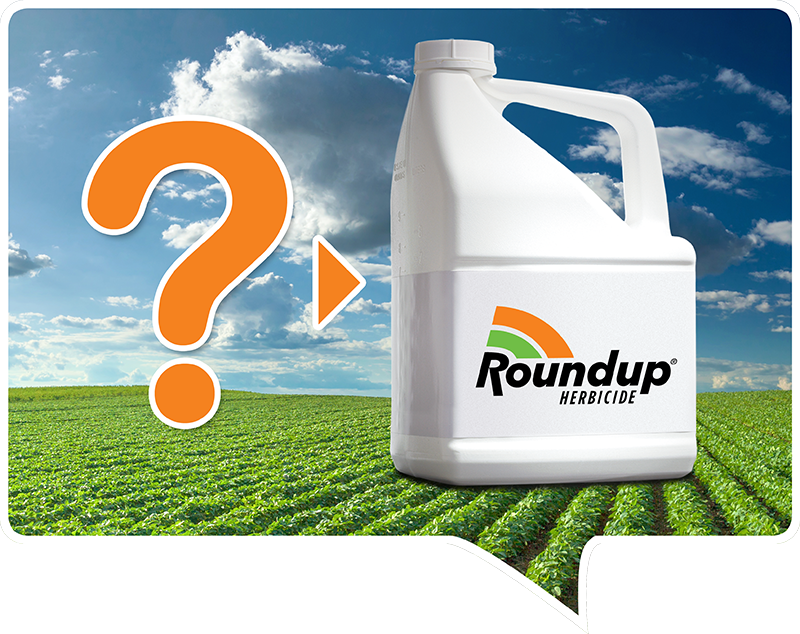Ultimate Roundup® FAQs
Nov 19, 2019
Roundup® is one of Canada’s longest serving and most versatile herbicides. Farmers love it for it’s consistent, powerful performance against the widest spectrum of weeds. But as familiar as it is to growers, agronomists and the like, how much do you really know? Here’s a collection of FAQs you may find quite interesting.

Q: When was Roundup Invented?
A: The short answer is 1970 – same year as the first 747 jumbo jet passenger flight.
A more fulsome answer is that glyphosate, the active ingredient in Roundup, was discovered by John E. Franz, an organic chemist who worked for Monsanto’s agricultural division in Springfield, Illinois. (He got $5 for his patent!1)
It took until 1974 to bring glyphosate to the US market under the name Roundup, and it was registered in Canada in 1976.
Q: How does Roundup work?
A: Glyphosate has a unique mode of action among Group 9 herbicides. It is the only active ingredient that works by interrupting a metabolic function (known as the shikimate pathway) that allows plants to create the essential amino acids they need to maintain protein synthesis. Essentially, plants have no natural way to metabolize glyphosate, so they wind up starving themselves to death.
Another interesting thing about how Roundup works is that it’s a relatively slow-acting, systemic herbicide. Think of it this way: good translocation takes time. So, because it takes a week to 10 days to fully move through the plant, glyphosate is extremely reliable when it comes to controlling weeds.
Q: Why do growers like Roundup?
A: Oh, so many reasons! Here are just a few:
- Non-selective. As a non-selective herbicide, Roundup has one of the widest weed spectrums available today. Grass or broadleaf weeds, annual or perennial – it doesn’t matter, Roundup can take care of most weed problems
- Easy to use. Roundup is easy to mix and easy to apply. Its concentrated formulation allows for easier handling and covers more acres with less product (compared to generics2).
- Effective. Unsurpassed, consistent weed control, even in tough growing conditions.
Q: How many weeds does Roundup control, and what are the toughest ones?
A: That depends on whether you’re using a Roundup Ready® canola system or not. If you’re using Roundup WeatherMAX® or Roundup Transorb® HC for pre- or post-burndown, there are over 70 annual and perennial weed species on the label.
The new TruFlex™ canola with Roundup Ready technology controls 51 weed species (24 more than the Roundup Ready® canola system), including some of the toughest for canola growers, like wild buckwheat, cleavers, thistles and dandelion.
Q: What are the benefits of TruFlex canola with Roundup Ready technology?
A: TruFlex canola with Roundup Ready technology allows for greater flexibility in spray timing and rates. Farmers can choose to make two sequential applications or one single application, depending on field conditions. This gives you a much wider application window where you can successfully go after late flushes of weeds. Using Roundup WeatherMAX, you’re looking at:
Rate:
- 0.67 litres per acre (sequential applications)
- 1.33 litres per acre (single application)
Timing:
- Cotyledon to first flower (sequential application)
- Cotyledon to 6-leaf (single application)
Q: What is the product’s rainfastness?
A: Roundup WeatherMAX is backed by our 30-Minute Rainfast Guarantee, and Roundup Transorb® HC is backed by our 60-Minute Rainfast Guarantee.
Q: What’s the current state of glyphosate resistance in Canada?
A: In Western Canada, glyphosate-resistant kochia was first reported in 2011. In Eastern Canada, glyphosate resistance has been documented in Canada fleabane, common ragweed, and waterhemp. Resistant waterhemp has also been found in southern Manitoba.
Q: What should I do to prevent glyphosate resistance developing in my fields?
A: Herbicide group rotation and using multiple, effective modes of action are critical to delaying and managing the onset of resistance – to any herbicide. Keep good records and be sure to scout fields post-application to check product performance and make note of any escapes. Other cultural weed control methods can also be effective in the management of herbicide resistance.
Q: Where can I find out more about herbicide resistance?
A: There are many online resources on herbicide resistance, including government websites. But a good place to start is Bayer’s MixItUp.ca site. This is a one-stop shop of information that covers everything resistance. And we mean everything – from understanding herbicide groups and the evolution of resistance, to the financial impact of the problem, to practical management tools for your farm plus a list of resources that will help you be the best resistance manager you can be.
Q: How do I get the best performance from my Roundup herbicide?
A: Like most herbicides, Roundup works best on small, actively growing weeds.
The weeds need to be actively growing in order for the glyphosate to effectively translocate through the plant. And the smaller the weeds are the better because small plants push the herbicide through faster. Spraying when it’s too cold (4C) or too hot (30C) is not recommended as plants tend to shut down in these temperatures and don’t properly absorb the active ingredient or effectively move it through its tissues.
Sources:
1 John Franz gets $5 for patent: https://web.archive.org/web/20080724175539/http://www.monsanto.com/features/franz_bio.asp
2 More acres with less product: Point 6 on this site: https://www.roundup.ca/en/the-roundup-advantage